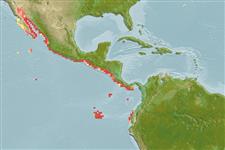Environment: milieu / climate zone / depth range / distribution range
Ecologia
marinhas associadas(os) a recifes; não migratória; intervalo de profundidade ? - 80 m (Ref. 55763), usually 30 - ? m (Ref. 89707). Tropical; 32°N - 3°S, 115°W - 80°W (Ref. 5222)
Eastern Pacific: Gulf of California to Ecuador and the Galapagos Islands.
Tamanho / Peso / Idade
Maturity: Lm ? range ? - ? cm
Max length : 39.0 cm TL macho/indeterminado; (Ref. 89707); common length : 20.0 cm TL macho/indeterminado; (Ref. 55763)
Espinhos dorsais (total): 9; Raios dorsais (total): 14-15; Espinhos anais 3; Raios anais : 8. Distinguished by the following characteristics: body depth 2.7-2.9 in SL; head length 2.3-2.5 in SL; rounded preopercle, finely serrate; posterior and anterior nostril subequal; third dorsal spine, longest, membranes incised between anterior spines; pectoral fins longer than pelvic fins, pectoral fin length 1.5-1.7 in head length; caudal fin rounded; lateral body scales strongly ctenoid; lateral line scales 48-49; lateral scale series 80-83 (Ref. 089707)
Found in coral reefs; also along rocky shores (Ref. 5222). A shy and secretive species (Ref. 5222). Feeds on fishes and crustaceans; reaches at least 25 years; recently confirmed as a protogynous hermaphrodite, spawning peaks in July and August in the Gulf of California (Ref. 089707).
Ciclo de vida ou comportamento de acasalamento
Maturidade | Reprodução | Desova | Ovos | Fecundidade | Larvas
Heemstra, P.C. and J.E. Randall, 1993. FAO Species Catalogue. Vol. 16. Groupers of the world (family Serranidae, subfamily Epinephelinae). An annotated and illustrated catalogue of the grouper, rockcod, hind, coral grouper and lyretail species known to date. Rome: FAO. FAO Fish. Synop. 125(16):382 p. (Ref. 5222)
Status na Lista Vermelha da UICN (Ref. 130435)
Ameaça para os humanos
Harmless
Uso pelos humanos
Mais informação
Nomes comunsSinônimosMetabolismoPredadoresEcotoxicologiaReproduçãoMaturidadeDesovaAgregação de desovaFecundidadeOvosDesenvolvimento dos ovos
ReferênciasAquaculturaPerfil para aquaculturaEstirpesGenéticaElectrophoresesHereditariedadeDoençasProcessamentoNutrientsConversão de massa
ColaboradoresFotosStamps, Coins Misc.SonsCiguateraVelocidadeTipo de nataçãoÁrea branquialOtólitosCérebrosVisão
Ferramentas
Relatórios especiais
Baixar XML
Fontes da internet
Estimates based on models
Preferred temperature (Ref.
123201): 17.9 - 26, mean 23.4 °C (based on 14 cells).
Índice de diversidade filogenética (Ref.
82804): PD
50 = 0.5000 [Uniqueness, from 0.5 = low to 2.0 = high].
Bayesian length-weight: a=0.01514 (0.00873 - 0.02625), b=3.07 (2.92 - 3.22), in cm total length, based on LWR estimates for this species & Genus-body shape (Ref.
93245).
Nível Trófico (Ref.
69278): 4.1 ±0.7 se; based on size and trophs of closest relatives
Resiliência (Ref.
120179): médio(a), tempo mínimo de duplicação da população 1,4 - 4,4 anos (tmax=4; k=0.19).
Fishing Vulnerability (Ref.
59153): Low to moderate vulnerability (29 of 100).
Nutrients (Ref.
124155): Calcium = 43.7 [25.8, 74.6] mg/100g; Iron = 0.523 [0.299, 0.967] mg/100g; Protein = 18.4 [16.6, 20.1] %; Omega3 = 0.167 [0.108, 0.262] g/100g; Selenium = 36.7 [20.7, 60.7] μg/100g; VitaminA = 186 [65, 595] μg/100g; Zinc = 0.803 [0.578, 1.278] mg/100g (wet weight);
